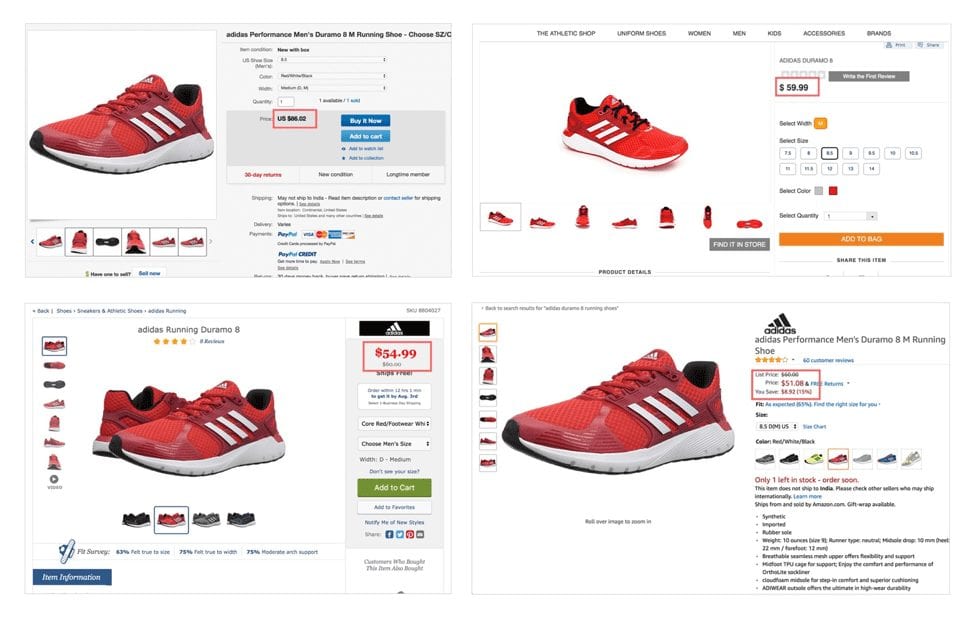With price playing such an important role in decision making, competitive and dynamic pricing are key in gaining competitive advantage. But, in this race to win the consumers by offering the lowest prices, retailers often breach the Minimum Advertised Price (MAP) policies, laid down by brands. It can serve as a disadvantage when the retailers sell their products at prices lower than those fixed by brands. It can also damage brand reputation and affect business for the brand. To keep control over excessive price variations, protect brands from corrosive prices, and ensure equal opportunities to all players in a retail landscape, the MAP pricing policy came into existence.
What is a Minimum Advertised Price?
MAP or Minimum Advertised Price is a pre-decided minimum price for a product that resellers agree to not advertise or sell below. For example, if an electronics brand has decided the Minimum Advertised Price for a particular cell phone model at $100, retailers and resellers both online as well as in-store, are obligated to sell this product at $100 or above.
Why Do Brands Need An MAP Pricing?

Today, with the growing e-commerce market, there is an increasing number of third-party marketplaces online and your products might be getting sold by thousands of retailers and resellers across the globe, some that brands might not even be aware of. This makes it crucial for brands to have visibility into the prices offered by all the resellers and whether they fall in line with their MAP pricing. Products sold at prices lower than the Minimum Advertised Price can affect the business for brands. It also hurts the brand and in most cases, affects the profits made by them.
7 Reasons MAP Pricing Must Be Monitored
Global Channels & complex retail network
You cannot afford to operate in analog mode anymore with your products being sold across a complex retail network.
The Age of Amazon
Without a way to monitor MAP pricing, your brand pricing seems doomed in a ‘race to the bottom’.
Fierce competition making competitive prices a necessity
Pricing also dictates visibility, seller ratings, etc. that directly influence buying decisions, reinforcing the importance of competitive pricing.
Limited control over individual sellers
With thousands of resellers across multiple channels and marketplaces, keeping up with that scale is hard.
No control over marketplace algorithms
For such a big reseller base, it is humanly impossible to monitor price changes at all times, manually.
Unauthorized sellers and resellers
With so many marketplaces, it’s impossible to keep tabs on authorized resellers, leave alone unauthorized sellers and resellers.
Counterfeiting and supplier encroachment
With the counterfeit industry posing a huge threat, protecting the brand is paramount.
Difference Between MAP And MSRP
The MSRP and MAP are very different from each other. MARP is the Manufacturer’s Suggested Retail Price. This is the price at which the retailers have purchased the product from the sellers. This is the price at which the sellers suggest the product be sold in the market. However, there is no restriction or limit at which the retailers sell the product in the market. Once the sale is made by the manufacturers, the retailers are at liberty to set any price they want.
This is where Minimum advertised price(MAP) comes into play. It sets the base price at which the retailers have to sell the product. It is a policy they need to adhere to. If it’s only the MSRP that is set, there is no balance enforced. While resellers can set any profit they want, the brick-and-mortar stores can rarely compete with their pricing.
However, there are also positives to MSRP. It is of great benefit to the customer as they can get products at good prices. This increases their options too. In the automobile industry, the MSRP has to be revealed to the customers. Making a comparison between the two can encourage customers to make a purchase.
How Can Brands Enforce Minimum Advertised Price effectively?
In today’s dynamic world of retail, enforcing and monitoring MAP compliance manually is a near-impossible feat. Any brand with an online presence today needs a legally comprehensive, AI-driven MAP enforcement process in place to ensure complete MAP compliance. Brands need the technology to monitor hundreds and thousands of their products sold online and keep sellers from violating their MAP terms in line with timely email intimations; all of this round-the-clock and round-the-globe!
Thanks to digital-first, AI-driven MAP monitoring solutions available in the market today, brands don’t have to invest in an in-house MAP monitoring team to monitor and track all resellers across all platforms. These advanced, intuitive MAP monitoring solution can be instantly deployed and can help brands go about their business with one less thing to worry about.

What are the advantages of implementing a MAP Monitoring Solution?
- A MAP monitoring solution can act as your eyes and ears in the market, flagging sellers that are non-compliant
- With nearly 80% of sellers online being unauthorized, monitoring for MAP closely can help identify and eliminate these sellers
- MAP monitoring can reduce operational and seller compliance costs by almost half.
- It can help prevent counterfeit goods from cannibalizing your market share.
- It can enable brands to grow & control a robust sales network by converting unregistered sellers into legitimized sellers.
- If there were MAP pricing policy signed, the manufacturers are liable to take legal action against the brands. They can even choose to terminate their listings. Retailers like Amazon and eBay are also liable to follow the set Minimum Advertised Price. If the retailers don’t comply even after a warning, then legal action can be taken.
How Can Brands Stand Out With Minimum Advertised Prices in Place?
Adhering to MAP pricing doesn’t mean resellers have to give up on profits or on consumer satisfaction and retention. Apart from offering the lowest prices, there are a number of ways to ensure your consumers keep coming back to you. Offering free shipping and returns, loyalty programs, and tailored offers are some of the ways to ensure your customer satisfaction.
Most shoppers research products before making a purchase. Though lower costs do attract customers, there are numerous other factors that come into play while making buying decisions including customer service, easy returns policies, tailored content, intelligent assortment, product availability, free delivery, etc. Retailers can always focus on improving customer satisfaction through a combination of these services, rather than violating MAP pricing policy just to get more sales and in turn harming the retail ecosystem.
When sellers follow the Minimum Advertised Prices, brands inform them of new products before anyone else in good faith. Hence, adhering to MAP pricing can create healthy relationships between brands and retailers and create a level playing field in the retail market.
The supreme court set a ruling that the manufacturers and the retailers can work together to set a minimum advertised price. This is for the benefit of both the parties in play. By working together, they can sell commodities at the best-valued price to the customers. It helps establish a level of uniformity. This also serves as a stepping stone to creating a balanced economy. The MAP pricing policy is essential for the retail industry. It will make sure that the product is not sold at a price lower than it is valued.
[“source=intelligencenode”]










